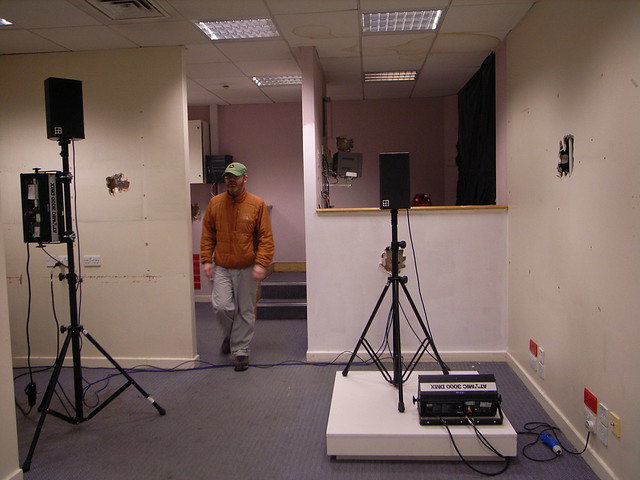|
|
|
mark fell please note this website is no-longer maintained. instead please visit http://www.markfell.com |
warning: this work contains...stroboscopic light and multichannel sound shown at "There is no solution because there is no problem" 5th to 13th march sheffield. see http://thereisnosolution.tumblr.com/ I presented two systems: lattice oscillation and decay study. These played for three minutes each in cycle.     decay studyThis piece used strobes in single trigger mode: both strobes triggered at the same time with a ten second space between triggers. Sound was three oscillator synthesis at high intensity; comprising pulse width oscillation from speaker 1, sawtooth from speaker 2, and sine from speaker 1 and sub. The decay of the sound is combined with the decay of the after image - a kind of green inverse of the room with an increasingly long decay. Visitors also noted that lights - including the small green and red LEDs on the back of lighting fixtures, and the small white power light on a mac mini - seemed to drift around the space independent of their original position. I have only included sonic documentation of this work as it is impossible to give an accurate representation of the effect using video. sound recording made with zoom h4n recorded @ 96k 24bit. lattice oscillation (not to be confused with lettuce oscillation)In this piece both strobes were given different flash rates with tight temporal sonic correlation. Although the sonic and visual rates were the same, these were temporally decoupled: the sound and visual stimulus reaching the percipient with varying delay. This phenomenon (which came about though a technical limitation of the control protocol) was intended to approximate the effect of a variation in distance of the object from the percipient (at long distances the visual stimulus will reach the percipient much quicker than the sonic stimulus as light travels faster than sound). here's a video please note: due to the speed of the strobe and the frame rate of the video, it is quite hard to give an accurate representation of the flashing - sometimes this results in a black band that moves up and down the screen, and sometimes an almost static gray. While shooting the video i experimented with different shutter speeds, frames per second and apertures. the footage included here reflects these different settings. Also, once compressed with the h264 codec, grid like artifacts occasionally become visible.  here is a youtube vid http://www.youtube.com/watch?v=7r7Tkgp8EjE from an unknown visitor.  this work was supported by electricfly productions (who provided the two high power strobes) and sightsonic (for the d&b pa system).
|